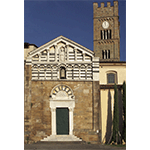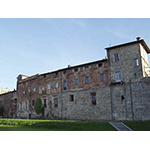Complesso degli Ospitalieri di Altopascio [Hospital Complex of Altopascio]
The city of Altopascio is linked to an ancient public welfare institution. The "spedale", or hospital, was founded in the second half of the 11th century by the Hospitaller Order of the "Brothers of San Jacopo d'Altopascio". The "Knights of Tau" – as the monks who wore a cloak marked with the Tau, symbol of the Order, were later called – provided assistance to pilgrims travelling along the Via Francigena. To the functions of providing safety, shelter and food were soon added those of medical treatment and hospitalisation. The hospital was one of the first institutions to progressively abandon its role of assistance in favour of a "medical" orientation, as a place where specific treatments were carried out. The monks' activity was governed by rules on lodging, nourishing and treating pilgrims, and called for the fixed presence in the hospital of four lay physicians and two surgeons. Examinations of urine and other necessary clinical activities were carried out. The hospital soon reached a position of absolute pre-eminence, attaining its highest peak of importance in the years between 1100 and 1200. In the early 14th century it slowly began to decline, due to the transfer of the seat of the Papacy to Avignon, to the war between Lucca and Florence fought at Altopascio and to the changed political conditions in Italy. In 1544 the hospital was taken over by Cosimo I de' Medici, who then assigned it to the Knightly Order of Santo Stefano. In the end, Sixtus V decreed that it be suppressed.
The hospital complex looked from the outside like a fortified castle protected by an imposing circle of walls. It was entered through the so-called Hospitallers’ Gate. To the left upon entering were the "Mansio" or "Magione", with the managerial and representational offices, and the storerooms (silos, enormous upside-down flasks holding the grain required to feed a constant flow of pilgrims and to resist in case of siege, can still be seen). Along the southern side was the Domus, residence of the Hospitallers, which has been remodelled several times, making it impossible to detect the original structure. At the back, a portico served as covered walkway from the Domus to the church. In the middle was a broad courtyard dominated by a stone well of octagonal shape. Beyond the portico were the pilgrims’ quarters.
Today, some traces of the small historic centre can be found in the layout. The halls and the loggia of Piazza Ospitalieri, the church of San Jacopo annexed to the hospital (extensively remodelled in 1827) and the pilgrims’ loggia are only a few of the signs of the prestigious institution that still survive, in spite of extensive rebuilding and remodelling over the centuries. The Documentation Centre on the Material Life of the Ancient Community displays objects from the 13th to the 19th century, including some ceramics marked with the symbol of the Tau.
****************************
Texts by Graziano Magrini
English translation by Catherine Frost
Last update 23/feb/2008





